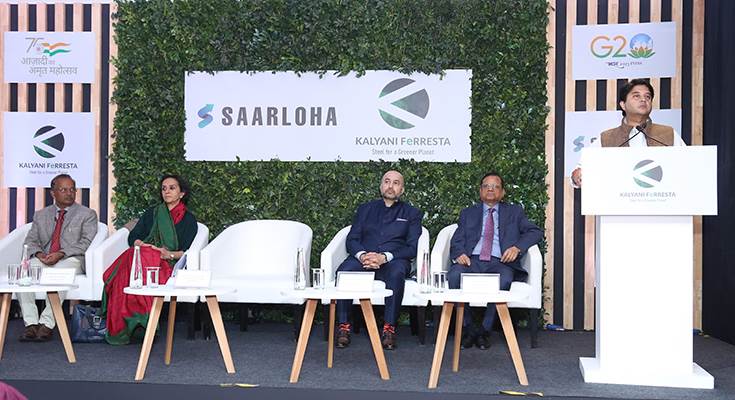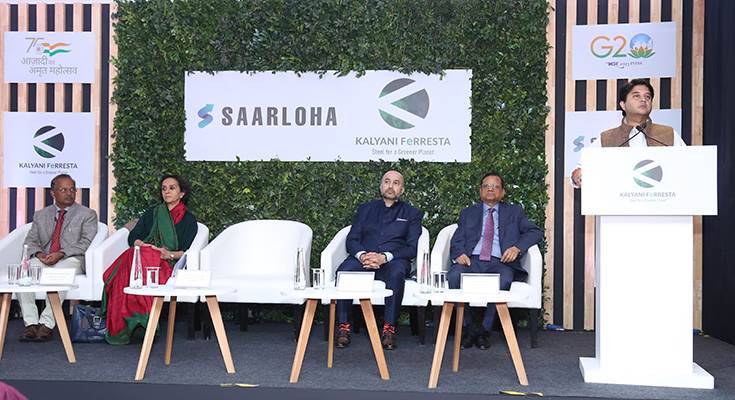Saarloha Advanced Materials (Saarloha), a Kalyani Group company, has introduced locally manufactured ‘green’ steel from its electric arc furnace plant in Pune, Maharashtra. The company has invested Rs 400 crore in switching the facility to 100 percent renewable energy from solar and wind to power its electric arc furnaces.
The 250,000 metric tonne capacity Saarloha plant in Pune will be able to produce long steel of various grades by minimising its greenhouse gas emission footprint to 140kg for every tonne of steel produced.
The plant has also seen additional capex in switching all its furnaces being fueled by furnace oil or PNG to run on the collective 83MW of clean electricity being produced in-house from solar and wind energy. “That is how we could minimise the CO2 emissions, which, in a normal electric arc or induction furnace plant would come out to be in the range of 1-1.5Ton for every Ton of steel produced,” said RK Goel, chairman, Saarloha Advanced Materials.
He further added that almost 50 percent of the steel produced in India is made by the electric arc or induction furnace methodology, and therefore, it is a low-hanging fruit and all of it can be easily converted into green steel by adoption of renewable energy by the steel industry.
In its composition, the Ferresta-branded steel also comprises of up to 70 percent scrap, which also plays an important role in lowering the overall carbon-dioxide emissions during the manufacturing process. The company is now looking for customers for its green steel, which, other than the automotive industry, is suitable for use in the aviation industry, oil-and-gas sector as well as in nuclear power plants.
Goel added that the adoption of green steel will pick up gradually over time and OEMs will have to see the cost with respect to bearing penalties for polluting the environment. “So far, there is no penalty but in due course, OEMs will have to assess the cost of green steel in relation to the cost of CO2 emissions. If we take that into consideration, it is much cheaper to use green steel than paying carbon-emission penalties,” he said.
“While the European government is looking at introducing such a measure, the US has already imposed duties on CO2 emissions during manufacturing of steel. As such penalties keep getting imposed globally, we will see an automatic switchover to green steel. Technically speaking, we are a little ahead of time,” Goel added.
Green steel an enabler for component exports
With India Component Inc exporting US$ 20 billion (Rs 164,940 crore) worth of automotive components to various global markets, Goel mentioned that the adoption of green steel can simply multiply the growth of the industry, which will also benefit from the fact that there are no such green steel plants in China yet.
“As per the information in the public, there are supposedly no green steel plants in China, so if we look at that, it is a very big opportunity for India,” he added.
At present, Saarloha supplies almost 70 percent of its green steel produce directly to Bharat Forge, which, in turn converts it into finished automotive components for export markets. “The use of green steel ensures that there is business continuity irrespective of the carbon duties in the global markets such as Europe,” Goel signed off.
Focus on sustainability
Speaking at the launch event in New Delhi, Amit Kalyani, deputy managing director, Bharat Forge, said, “We have looked at ESG independently and have also combined the three into our CSR initiatives for the betterment of the society. Our decarbonisation roadmap includes involving suppliers, and the entire value chain. Given the abundance on sunlight and wind in India, have pledged to switch to fully renewable energy by 2030.”
The Minister of Steel and Civil Aviation, Jyotiraditya Scindia, who was also present at the event, said, “Steel is the founding precept of any developed economy around the world and so is the case with India as our economy prospers and grows. Steel becomes the raw material for various successive industries down the value chain and therefore, it is imperative that India becomes a responsible producer of steel in the world. Therefore, the government has put in place a Green Steel Policy from an ESG perspective and it aims to offer demand-side and supply-side drivers.”
India is the world’s second-largest crude steel producer but the sector is also plagued with high carbon emissions. Steel industry is globally the fifth-largest emitter of CO2 and contributes 7 percent to the global CO2 emissions. In India, however, this number is slightly higher at 12 percent.

